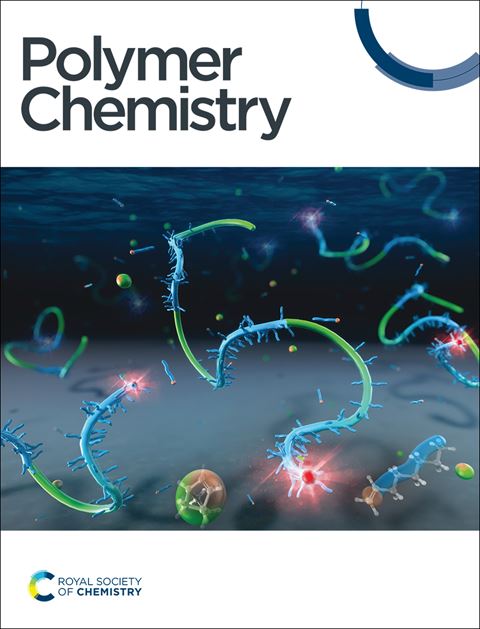溶剂和温度对聚乙二醇甲基丙烯酸酯光干扰素RAFT聚合的影响
IF 4.1
2区 化学
Q2 POLYMER SCIENCE
引用次数: 0
摘要
由于其高度“活”的性质,光干涉(PI)-RAFT聚合是一种很有前途的方法来合成广泛的(甲基)丙烯酸和苯乙烯聚合物。起始片段和链转移片段之间缺乏不平衡,使传统RAFT固有的双分子终止最小化。聚(聚乙二醇)甲基丙烯酸甲酯(P(PEGMA))是一种潜在的生物相容性材料,用于生物医学应用,但PEGMA的高活性自由基使其聚合控制具有挑战性。在这项研究中,我们研究了通过PI-RAFT合成P(PEGMA)。目前对PI-RAFT机理的研究有限,溶剂对动力学的影响尚未见报道。我们改变了几个反应条件:激发波长、单体浓度、温度和溶剂。传播常数kp值受RAFT主平衡的影响。我们计算了不同溶剂中聚合反应的Arrhenius参数、活化焓(Δ𝐻‡)和活化熵(ΔS‡)。回归分析结果与CTA在7种常用溶剂中的消光系数、溶剂物性和溶剂致变色尺度进行拟合。有效碰撞因子A与消光系数的指数回归模型拟合较好,表明CTA的反应速率与激发之间存在较强的关系。溶剂极性量表,如Kalmet-Abraham-Taft (KAT)和Catalan参数,无法预测kp、Arrhenius参数Δ𝐻‡和ΔS‡。A链转移常数Ctr >;1对所有的合成表明相对较好的控制聚合通过退化链转移与CTA自由基。总的来说,Ctr随温度升高而降低,这是由于光子吸收激发速率不变,而kp随温度升高而增加的结果。苯甲醚为最佳溶剂,在40℃下仍能保持Ð = 1.30。本文章由计算机程序翻译,如有差异,请以英文原文为准。
Solvent and Temperature Effects in the Photoiniferter RAFT Polymerisation of PEG Methacrylate
Photoiniferter (PI)-RAFT polymerization is a promising approach to synthesise a broad range of (meth)acrylic and styrenic polymers because of its highly ‘living’ nature. The lack of an imbalance between initiating and chain-transfer fragments minimises the inherent bimolecular termination of conventional RAFT. Poly(poly(ethylene glycol) methyl ether methacrylate) (P(PEGMA)) is a potential biocompatible material for biomedical applications, but the highly reactive free radical of PEGMA makes control of its polymerisation challenging. In this study, we investigated the synthesis of P(PEGMA) through PI-RAFT. Current studies on the PI-RAFT mechanisms are limited and the effect of solvents on kinetics has not been reported. We varied several reaction conditions: excitation wavelengths, monomer concentrations, temperatures, and solvents. The propagation constant (kp) values were affected by the RAFT main equilibrium. We calculated the Arrhenius parameters, enthalpy of activation (Δ𝐻‡), and entropy of activation (ΔS‡) for polymerization in various solvents. Regression analysis was conducted to fit the results with extinction coefficients of CTA in seven common solvents, solvent physical properties, and solvatochromic scales. The effective collision factor A had a good fitting with an exponential regression model of the extinction coefficients, indicating a strong relationship between the reaction rate and excitation of the CTA. Solvent polarity scales, such as Kalmet-Abraham-Taft (KAT) and Catalan parameters, failed to predict kp, Arrhenius parameters, Δ𝐻‡, and ΔS‡. A chain transfer constant Ctr > 1 for all syntheses indicated relatively good control over the polymerization through degenerative chain transfer with CTA radicals. In general, Ctr decreased with increasing temperatures, a result of the rate of excitation by photon absorption being constant, but the kp being increased by the temperature. Anisole was the best solvent, able to keep Ð = 1.30 even at 40 °C.
求助全文
通过发布文献求助,成功后即可免费获取论文全文。
去求助
来源期刊

Polymer Chemistry
POLYMER SCIENCE-
CiteScore
8.60
自引率
8.70%
发文量
535
审稿时长
1.7 months
期刊介绍:
Polymer Chemistry welcomes submissions in all areas of polymer science that have a strong focus on macromolecular chemistry. Manuscripts may cover a broad range of fields, yet no direct application focus is required.
 求助内容:
求助内容: 应助结果提醒方式:
应助结果提醒方式:


